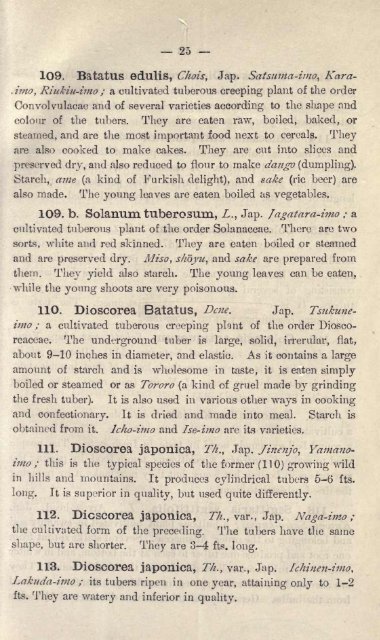Untitled - Library
Untitled - Library
Untitled - Library
You also want an ePaper? Increase the reach of your titles
YUMPU automatically turns print PDFs into web optimized ePapers that Google loves.
25<br />
.<br />
into, Riukiu-imo ; a cultivated tuberous creeping plant of the order<br />
Convolvulacae and of several varieties according to the shape and<br />
colour of the tul>ers. They are eaten raw, boiled, baked, or<br />
steamed, and are the most important food next to cereals. They<br />
are also cooked to make cakes. They are cut into slices and<br />
preserved dry, and also reduced to flour to make dango (dumpling).<br />
Starch, ame, (a kind of Furkish delight), and sake (ric beer) are<br />
also made. The young leaves are eaten boiled as vegetables.<br />
109. b. Solanum tuberosum, L., Jap. fagatara-imo ; a<br />
cultivated tuberous plant of the order Solanaceae. There are two<br />
sorts, white and red skinned. They are eaten boiled or steamed<br />
and are preserved dry. Miso, shoyu, and sake are prepared from<br />
them. They yield also starch. The young leaves can be eaten,<br />
while the young shoots are very poisonous.<br />
110. Dioscorea BatatllS, Dene.<br />
1O9. BatatUS edulis, Chois, Jap. Satsuma-iino, Kara-<br />
Jap. Tsnkuneimo<br />
; a cultivated tuberous creeping plant of the order Dioscoreaceae.<br />
The underground tuber is large, solid, irrerular, flat,<br />
about 9-10 inches in diameter, and elastic. As it contains a large<br />
amount of starch and is wholesome in taste, it is eaten simply<br />
boiled or steamed or as Tororo (a kind of gruel made by grinding<br />
the fresh tuber).<br />
It is also used in various other ways in cooking<br />
and confectionary. It is dried and made into meal. Starch is<br />
obtained from it.<br />
Icho-imo and Ise-imo are its varieties.<br />
111. Dioscorea japonica, 77*., Jap. Jinenjo, Yamanoimo<br />
; this is the typical species of the former (110) growing wild<br />
in hills and mountains. It produces cylindrical<br />
long.<br />
It is superior in quality, but used quite differently.<br />
tubers 5-6 fts.<br />
112. Dicscorea japonica, 77*., var., Jap. Naga-imo ;<br />
the cultivated form of the preceding. The tubers have the same<br />
shape,<br />
but are shorter. They<br />
are 3-4 fts. long.<br />
113. Dioscorea japonica, 77*., var., Jap. Ichincn-imo,<br />
Lakitda-iino ; its tubers ripen in one year, attaining only to 1-2<br />
fts.<br />
They are watery and inferior in quality.
















